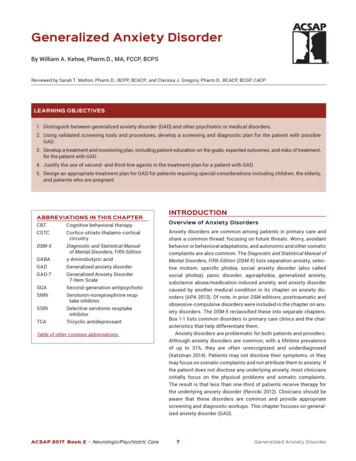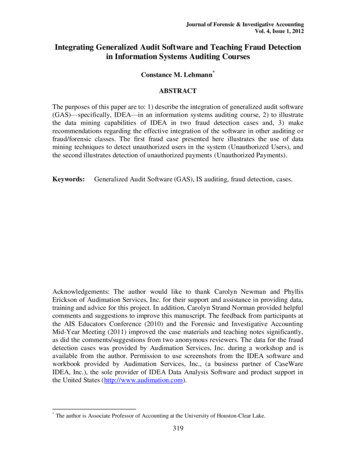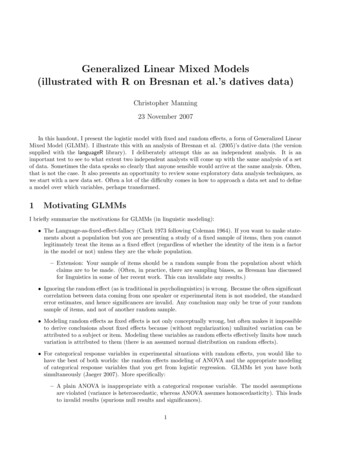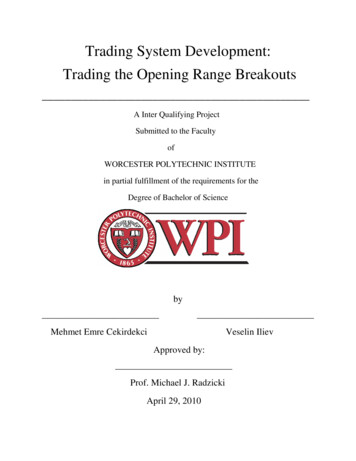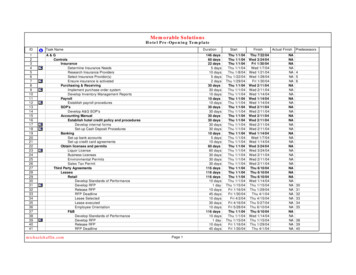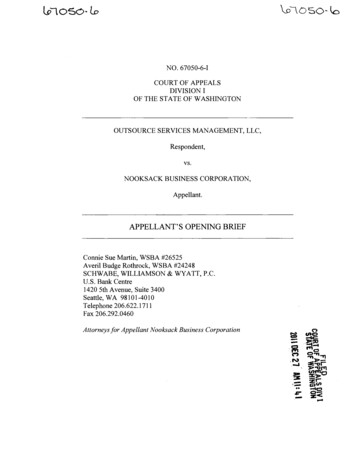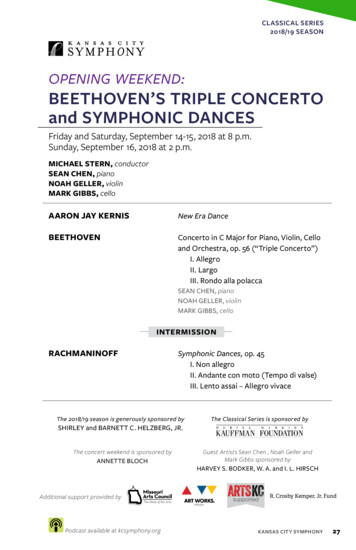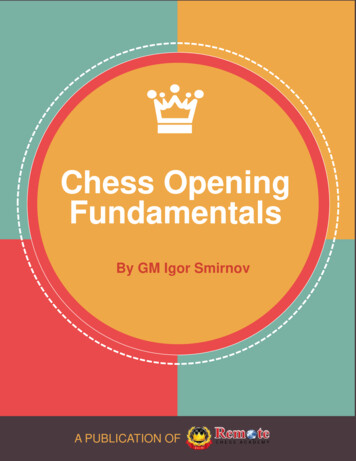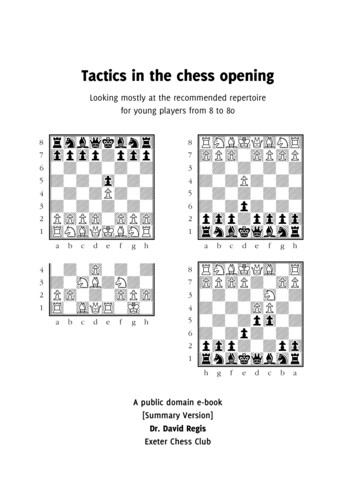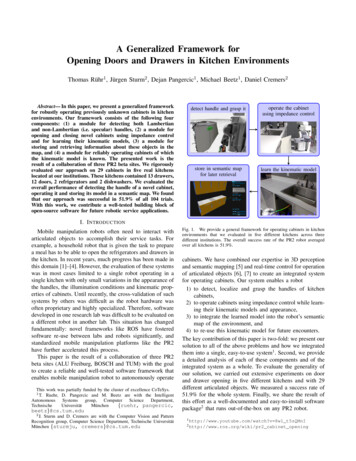
Transcription
A Generalized Framework forOpening Doors and Drawers in Kitchen EnvironmentsThomas Rühr1 , Jürgen Sturm2 , Dejan Pangercic1 , Michael Beetz1 , Daniel Cremers2Abstract— In this paper, we present a generalized frameworkfor robustly operating previously unknown cabinets in kitchenenvironments. Our framework consists of the following fourcomponents: (1) a module for detecting both Lambertianand non-Lambertian (i.e. specular) handles, (2) a module foropening and closing novel cabinets using impedance controland for learning their kinematic models, (3) a module forstoring and retrieving information about these objects in themap, and (4) a module for reliably operating cabinets of whichthe kinematic model is known. The presented work is theresult of a collaboration of three PR2 beta sites. We rigorouslyevaluated our approach on 29 cabinets in five real kitchenslocated at our institutions. These kitchens contained 13 drawers,12 doors, 2 refrigerators and 2 dishwashers. We evaluated theoverall performance of detecting the handle of a novel cabinet,operating it and storing its model in a semantic map. We foundthat our approach was successful in 51.9% of all 104 trials.With this work, we contribute a well-tested building block ofopen-source software for future robotic service applications.detect handle and grasp itoperate the cabinetusing impedance controlstore in semantic mapfor later retrievallearn the kinematic modelI. I NTRODUCTIONMobile manipulation robots often need to interact witharticulated objects to accomplish their service tasks. Forexample, a household robot that is given the task to preparea meal has to be able to open the refrigerators and drawers inthe kitchen. In recent years, much progress has been made inthis domain [1]–[4]. However, the evaluation of these systemswas in most cases limited to a single robot operating in asingle kitchen with only small variations in the appearance ofthe handles, the illumination conditions and kinematic properties of cabinets. Until recently, the cross-validation of suchsystems by others was difficult as the robot hardware wasoften proprietary and highly specialized. Therefore, softwaredeveloped in one research lab was difficult to be evaluated ona different robot in another lab. This situation has changedfundamentally: novel frameworks like ROS have fosteredsoftware re-use between labs and robots significantly, andstandardized mobile manipulation platforms like the PR2have further accelerated this process.This paper is the result of a collaboration of three PR2beta sites (ALU Freiburg, BOSCH and TUM) with the goalto create a reliable and well-tested software framework thatenables mobile manipulation robot to autonomously operateThis work was partially funded by the cluster of excellence CoTeSys.1 T. Ruehr, D. Pangercic and M. Beetz are with the epartment,TechnischeUniversitätMünchen{ruehr, pangercic,beetz}@cs.tum.edu2 J. Sturm and D. Cremers are with the Computer Vision and PatternRecognition group, Computer Science Department, Technische UniversitätMünchen {sturmju, cremers}@cs.tum.eduFig. 1. We provide a general framework for operating cabinets in kitchenenvironments that we evaluated in five different kitchens across threedifferent institutions. The overall success rate of the PR2 robot averagedover all kitchens is 51.9%.cabinets. We have combined our expertise in 3D perceptionand semantic mapping [5] and real-time control for operationof articulated objects [6], [7] to create an integrated systemfor operating cabinets. Our system enables a robot1) to detect, localize and grasp the handles of kitchencabinets,2) to operate cabinets using impedance control while learning their kinematic models and appearance,3) to integrate the learned model into the robot’s semanticmap of the environment, and4) to re-use this kinematic model for future encounters.The key contribution of this paper is two-fold: we present oursolution to all of the above problems and how we integratedthem into a single, easy-to-use system1 . Second, we providea detailed analysis of each of these components and of theintegrated system as a whole. To evaluate the generality ofour solution, we carried out extensive experiments on doorand drawer opening in five different kitchens and with 29different articulated objects. We measured a success rate of51.9% for the whole system. Finally, we share the result ofthis effort as a well-documented and easy-to-install softwarepackage2 that runs out-of-the-box on any PR2 robot.1 http://www.youtube.com/watch?v 8w1 t5zQMnI2 http://www.ros.org/wiki/pr2 cabinet opening
II. R ELATED W ORKWe review the related work with respect to the above listedcontributions.A. Handle DetectionThere have been various approaches en route to solvethe handle perception problem. Klingbeil et al. [2] proposea solution based on a 2D-sliding window object detectionalgorithm and a supervised learning scheme that producesa dictionary of features consisting of localized templatesfrom cropped training examples. Then a binary classifier islearned using boosted decision trees to select the set of bestmatching feature matches. In [8] Arisumi et al. propose theidentification of knobs and handles using stereo vision andMaximally Stable Extremal Region which requires certainassumptions about the size, height and location of the blobin the image. In contrast, our approach makes use of 3Dpoint cloud clustering in Euclidean space [9] and will bepresented in subsection IV-A. A general problem are surfaceswith specularity, as specular surfaces are typically not visiblein 3D scans. In our approach, we explicitly exploit this factby specifically searching for handles in regions with missingrange values.Fig. 2. Testbed kitchens at the Bosch RTC facility. The upper cabinets aretoo high and could not be reached by the PR2.B. Operating Cabinets and Model LearningOther researchers have focused on the problem of operating doors and drawers using mobile manipulation robots.Many of these approaches make strong assumptions aboutthe kinematics of the articulated object, in particular foropening room doors [2], [3], [10]–[12]. When no kinematicmodel of the articulated object is available, force- andimpedance-controlled methods have proven successful [13],[14]. In our own recent work [7], we demonstrated howarticulated objects can be operated using a combination ofreal-time impedance control and kinematic model learning.C. Modelling of Cabinet AppearanceA framework for in-hand-modeling of objects is proposedin [15]. It uses a two step approach for background subtraction, considering the distance to the gripper and searchingfor components connected to the gripper. Both steps useassumptions not present in our scope of application, wherethe background is close to and topologically connectedwith the articulated object. In [16], an approach for thecreation of a skin and skeleton model of piecewise rigidarticulated objects from 3D point clouds is presented. Itis limited in the presence of sliding parallel planes, as theunderlying ICP algorithm creates false correspondences. Weavoid this by incorporating the learned articulation model inthe estimation of the transformation between correspondingpoints in consecutive frames.D. Semantic MapsWe use the KnowRob [17] knowledge processing systemto store the articulation models and handle poses as part ofthe semantic map of our environment. In [18] another systemfor building the internal representations of space for robotsFig. 3.Testbed kitchen at TUM IAS.to act in human living environments is proposed. While theirsystem can build conceptual and extensible semantic mapsthat are useful for the classification of places and scenes,they do not have a possibility to learn and store articulationmodels for opening cabinets.E. The system as a wholeIn this paper, we present an integrated system that enablesrobots to operate cabinets in kitchen environments. Theperformance of the system as a whole as well as all individualparts were evaluated in five different kitchens, on 29 objectsand in more than 100 trials. To the best of our knowledge,no other approach to cabinet opening has been evaluatedso extensively. In contrast to our previous work [5] weherein also overcome the assumptions about the thick andrectangular handles which were needed i) for the reliabledetection of them, and ii) for the operating of the cabinetsbased on large overlaps between the surface of the handleand the gripper.III. S YSTEM A RCHITECTUREThe individual processing steps of our approach are visualized in Fig. 1. We assume that an initial semantic mapof the environment has been built a priori and is availablein KnowRob [17]. The map contains information about theenvironment such as a map for localization, approximatecabinet sizes and poses, rough handle poses, etc. The userstarts by specifying a coarse coordinate of a new cabinet tobe opened and the robot retrieves the stored handle pose,navigates towards it and starts a detection for it to verify
Fig. 4. 3D point cloud-based handle detector. Left: handles on cabinets inTUM’s kitchen and hd distance between the cabinet face and the handle,right: detection of the handles (blue points) in the original 3D point cloud(red points) of the cabinet from the left photo.the stored handle pose. In case of multiple handles arefound, the one closest to the stored handle pose is selected.Subsequently, the robot grasps the handle, switches to animpedance-based cartesian controller and pulls the handlebackwards. While the handle moves, the robot continuouslyestimates the articulation model from its observed toolframetrajectory and uses it to update the equilibrium point fed tothe cartesian controller. After the motion comes to a rest,the robot closes the cabinet again by generating cartesianequilibrium points along the learned model. Subsequently,we sample points of the learned model in regular stepsand re-execute it with a simple joint space PID controllerusing inverse kinematics to verify the validity of the learnedmodel. At the same time, we record point clouds of thearticulated object in these regular steps that are used for the3D reconstruction of the articulated bodys.IV. T WO APPROACHES TO HANDLE DETECTIONTo enable a reliable and robust manipulation of kitchencabinets the robot must first recognize and find relevantfixtures, such as handles, which indicate the presence ofdoors. To find the cabinet candidates in a certain roomwe first acquire a 3D point cloud model of a room usinga Kinect sensor and then apply a sequence of processingsteps to classify the previously obtained point cloud intosub-parts such as ceiling, floor, walls and furniture cabinets.Furthermore we segment out the front faces of the cabinetsusing a RANSAC-based segmentation of planes and thusobtain a vertical region of interest (ROI) which the robotis to explore. The final result of this process is stored into asemantic map as described in [5].Given the large variation in the appearances and locationsof doors and door handles, this is a challenging perceptionproblem. In this paper, we focus on the case of doors withdoor handles. We identified two types of handle appearancesthat have different characteristics with respect to sensor data:handles that have specular reflection (Fig. 4) and the ones thatdo not (Fig. 5). To tackle these two distinct cases we proposea two-fold approach that first tries to recognize and localizea handle in a full 3D model of the given environment. Shallthe latter fail we resolve to finding the handle in the partsof the 3D model that lacks range measurements due to thereflection of the sensor’s projected infrared light pattern onspecular surfaces.Fig. 5.Visualization of the processing steps for the handle detectorbased on invalid measurements. Top-left: example of two specular handles,top-middle: invalid measurements in place of specular handles as seenin a point cloud by Kinect, top-right: final handle poses (green spheres)computed from the generated convex hulls visualized in the corner of thesubfigure, bottom-left: cabinet front face as binary mask (white), bottommiddle: invalid measurements as binary mask (white), bottom-right: resultof a bit-wise conjuction operation.A. Detection of Handles without SpecularityWe apply a refined version of the approach proposed byRusu et al. [9] which uses 3D point cloud data as an input andassumes that the handles are to be found at a certain distancehd from a segmented plane of a door along the normaldirection of the plane. The parameter hd is given by theADA (Americans with Disabilities Act) requirements as themaximum distance from a door plane where a handle couldbe located. Their pipeline gets all points whose distance fromthe plane model is smaller than hd , and checks whether theirprojection on the plane falls inside the bounding polygon ofthe plane. The actual handle is obtained by first projecting thehandle on the door plane, and then fitting the best line withina plane parallel to the door in it using a RANSAC-based linefitting to infer the correct orientation. The geometric centroidof the handle cluster is then used along with the orientationof the line and the plane normal to grasp the handle (seeFig. 4).B. Detection of Handles with SpecularityThe handle detector described in the previous subsectionworks well when the handle is thick enough to be visible inthe 3D point clouds acquired by the robot. In practice, wefound that this strategy fails when the handles are too thin orspecular, so that they are not seen by the sensor. Technically,the Kinect sensor requires a large enough block of theprojected pattern to be visible to compute the disparity [19].In case of thin or specular handles the infrared pattern getsreflected, which results in low correlations during blockmatching so that the sensor returns missing values in theseregions (see Fig. 5, top-middle).Our key idea is thus to actively exploit
doors. To find the cabinet candidates in a certain room we first acquire a 3D point cloud model of a room using a Kinect sensor and then apply a sequence of processing steps to classify the previously obtained point cloud into sub-parts such as ceiling, floor, walls and furniture cabinets. Furthermore we segment out the front faces of the cabinets
